Quick Review
Architecture and Hosting Model
- Fundamental Redesign:
- ASP.NET Core is a complete, cross-platform rewrite of the original ASP.NET Framework, designed to be modular, lightweight, and high-performance.
- It uses a “pay-for-play” model with NuGet packages, allowing applications to include only the components they need.
- Unlike the Windows-only legacy framework, it is open-source and runs on Windows, macOS, and Linux.
- Its architecture is ideal for modern application patterns like microservices and containerization with Docker.
- Application Startup Process:
- An ASP.NET Core application starts as a console app that configures and launches a web host.
- The modern “minimal hosting model” (introduced in.NET 6) consolidates all startup configuration into a single
Program.csfile, replacing the olderStartup.csclass. - The
WebApplicationBuilderis used to set up essential services, configuration, logging, and the dependency injection container. - The resulting
WebApplicationinstance (app) is then used to define the request processing pipeline.
- Kestrel Web Server:
- Kestrel is the default, high-performance, cross-platform web server included with ASP.NET Core.
- Its design is based on asynchronous I/O, allowing it to handle thousands of concurrent connections efficiently with minimal resources.
- It can be deployed in two primary ways:
- Edge Server: Running standalone and facing the internet directly.
- Reverse Proxy: Running behind a more robust server like IIS, Nginx, or Apache, which is the recommended production setup for handling tasks like SSL termination, load balancing, and enhanced security.
Request Processing Pipeline and Middleware
- Core Concepts:
- Incoming HTTP requests are processed by a request pipeline, which is a sequence of components called middleware.
- Each middleware component can inspect or modify the request and response, pass control to the next component, or terminate the pipeline (a process known as short-circuiting).
- This architecture is a powerful implementation of the Chain of Responsibility design pattern.
- Pipeline Configuration and Order:
- The pipeline is constructed in
Program.csusing anIApplicationBuilderinstance (theappvariable). - Key extension methods like
app.Use(),app.Run(), andapp.Map()are used to add and branch middleware. - The order of middleware is critical for functionality, security, and performance. Components execute sequentially for incoming requests and in reverse order for outgoing responses.
- A typical production pipeline order is: Exception Handling -> HTTPS Redirection -> Static Files -> Routing -> Authentication -> Authorization -> Endpoints.
- The pipeline is constructed in
- Custom Middleware:
- Developers can create custom middleware to handle cross-cutting concerns.
- This can be done inline with lambda expressions for simple logic or as reusable, convention-based classes that have a constructor and an
InvokeAsyncmethod.
Dependency Injection (DI)
- Foundational Principle:
- DI is a core, first-class feature of ASP.NET Core, not an optional add-on.
- It enables loose coupling by allowing classes to depend on abstractions (interfaces) rather than concrete implementations, which makes code more testable, flexible, and maintainable.
- It is the mechanism for achieving Inversion of Control (IoC) and adhering to the Dependency Inversion Principle (DIP).
- Built-in IoC Container:
- ASP.NET Core includes a simple yet powerful IoC container.
- Registration: In
Program.cs, services are registered with the container by mapping an interface to a concrete class (e.g.,builder.Services.AddScoped<IUserService, UserService>()). - Resolution: When a service is needed (e.g., in a controller’s constructor), the container automatically creates an instance of the required class and its entire dependency graph.
- Service Lifetimes:
- The IoC container manages the lifetime of the objects it creates. Choosing the correct lifetime is crucial.
- Transient: A new instance is created every time the service is requested. Best for lightweight, stateless services.
- Scoped: A single instance is created for each client request (scope). This is the most common lifetime, perfect for services like a database context that should be shared within a single request.
- Singleton: A single instance is created once for the entire application’s lifetime. Used for global, thread-safe services like a caching service.
- DI in Practice:
- Constructor Injection: The most common and recommended pattern, where dependencies are requested as parameters in a class’s constructor.
- Middleware Injection: This is a special case. Because middleware components are singletons (created once at startup), you cannot inject a scoped service (like a
DbContext) into their constructor. Doing so would create a “captive dependency” and cause a runtime error.- Solution: Scoped services must be injected directly into the middleware’s
InvokeAsyncmethod, which is executed once per request.
- Solution: Scoped services must be injected directly into the middleware’s
Introduction
Objective Statement
This article provides an exhaustive, expert-level analysis of the ASP.NET Core framework. It deconstructs the foundational architectural principles, dissects the request processing pipeline, and offers a deep dive into its integrated Dependency Injection (DI) system.
Core Thesis
The report will argue that ASP.NET Core’s defining characteristics—high performance, cross-platform capability, and modularity—are not merely a collection of features but the direct results of a deliberate and fundamental architectural redesign. This redesign, centered on principles of Inversion of Control (IoC), establishes a new paradigm that breaks decisively from the monolithic, Windows-centric legacy of the ASP.NET Framework.
Part I: The Architectural Foundation of ASP.NET Core
Section 1.1: A Paradigm Shift from the.NET Framework
The emergence of ASP.NET Core in 2016 represented more than an incremental update to its predecessor, ASP.NET; it was a complete and fundamental reimagining of Microsoft’s web development stack.1 This redesign was not arbitrary but a direct response to the evolving demands of modern software development, prioritizing modularity, cross-platform reach, and raw performance. Understanding this paradigm shift is essential to grasping the “why” behind every component of the framework’s architecture.
Deconstructing Monolithic vs. Modular Architecture
The legacy ASP.NET Framework is best characterized as a monolithic architecture, deeply integrated with the Windows operating system and its Internet Information Services (IIS) web server.2 Applications built on this framework carried the weight of the entire.NET Framework runtime, a large and comprehensive library that made applications inherently heavyweight, regardless of whether all its features were used.
ASP.NET Core shatters this model by adopting a modular and lightweight architectural paradigm.4 It was rewritten from the ground up, freed from the constraints of backward compatibility with the older framework.1 Its functionality is delivered as a collection of granular NuGet packages. This “pay-for-play” model allows developers to include only the components and libraries their application specifically requires.1 The result is a leaner, more efficient application with a smaller footprint, streamlined deployment, and greater portability.1 This foundational decision to embrace modularity is the root cause from which the framework’s other defining characteristics logically flow. Because applications are composed only of necessary components, they are inherently more lightweight. This lightweight nature is a direct contributor to the framework’s high performance and its efficiency when containerized, as it leads to significantly smaller Docker images.2
The Implications of Being Cross-Platform and Open-Source
A primary driver for the creation of the underlying.NET Core runtime was the strategic need to break free from Windows dependency.1 ASP.NET Core is built on this runtime, enabling developers to build and deploy applications seamlessly across Windows, macOS, and Linux environments.3 This stands in stark contrast to the Windows-centric.NET Framework, opening up a broader range of hosting options and aligning with development trends where non-Windows environments are prevalent.2
Furthermore, the framework’s open-source nature has cultivated a dynamic and growing community.3 This fosters transparency, encourages contributions, and ensures that the framework evolves rapidly to meet modern challenges. It benefits from official support and timely updates from Microsoft, ensuring long-term viability, while also attracting a wider array of modern third-party libraries compared to the mature but more static ecosystem of the.NET Framework.4
Performance as a Core Design Tenet
The research is unequivocal: ASP.NET Core was meticulously engineered for superior performance and scalability.2 Microsoft purposefully rebuilt many features, aiming to improve performance in areas where the previous approach was “if it isn’t broke, don’t fix it”.1 These performance gains are a direct result of its modular architecture, an optimized runtime, a new just-in-time (JIT) compiler, and the inclusion of Kestrel, a high-performance web server, as the default request listener.1 For systems with high-performance needs, such as those composed of hundreds of microservices, Microsoft explicitly recommends ASP.NET Core to reduce server and virtual machine overhead, leading to both cost savings and an improved user experience.7
Suitability for Modern Paradigms
The architectural choices made in ASP.NET Core directly position it as the premier framework for contemporary application patterns. The modular design, which allows for mixing technologies and independent deployment, is perfectly suited for building microservices architectures.4 This same lightweight and modular characteristic makes it highly effective for containerization with tools like Docker. While the.NET Framework can be containerized, the resulting image size is substantially larger, making ASP.NET Core the more efficient choice.1 The framework is also described as “cloud-ready,” incorporating features essential for cloud-native development, such as a flexible, environment-based configuration system and built-in dependency injection.3
| Attribute | ASP.NET Framework | ASP.NET Core |
| Architecture | Monolithic; tightly coupled with System.Web.dll and Windows. | Modular; composed of granular NuGet packages. Lightweight and flexible. |
| Platform | Windows-only. | Cross-platform (Windows, macOS, Linux). |
| Performance | Good, but limited by monolithic design and reliance on Windows CLR. | High-performance; optimized for speed, scalability, and modern workloads. |
| Hosting | Tightly coupled with IIS. | Flexible; self-hosted with Kestrel, or run behind a reverse proxy (IIS, Nginx, Apache). |
| Dependency Injection | Not built-in; requires manual setup or third-party containers (e.g., Unity, Ninject). | First-class citizen; built-in IoC container is central to the framework. |
| Programming Models | Separate frameworks for Web Forms, MVC, and Web API. | Unified model for MVC, Web API, Razor Pages, and Minimal APIs. |
| Primary Use Cases | Legacy enterprise Windows applications, Web Forms applications. | Modern cross-platform web apps, cloud-native services, microservices, and containerized applications. |
Table 1: Architectural Comparison: ASP.NET Core vs. ASP.NET Framework. This table synthesizes key differences highlighted across sources.1
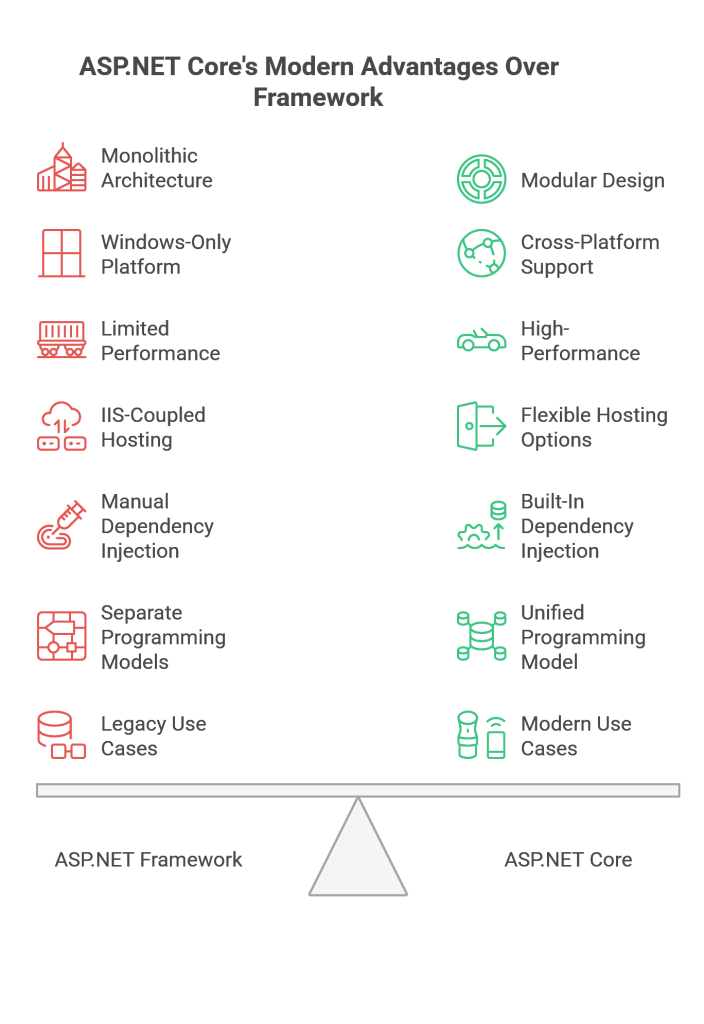
Section 1.2: The Application Host and Startup Process
An ASP.NET Core application is, at its heart, a console application that configures and launches a web host.11 The framework provides a robust hosting infrastructure responsible for application startup, lifetime management, and the configuration of essential services.
The Generic Host
Modern ASP.NET Core applications are built upon the “Generic Host” (IHost). This host is not specific to web applications and can be used for other application types like background services. When used for a web application, it is configured as a web host. The host is responsible for bootstrapping the application, which includes setting up core cross-cutting concerns such as logging, configuration, and, most importantly, the dependency injection container.12
The Modern Startup Model (.NET 6+)
With the release of.NET 6, Microsoft introduced a “minimal hosting model” that significantly streamlined the application startup process. This change eliminated the traditional Startup.cs file and consolidated its responsibilities into a single Program.cs file, reducing boilerplate code and simplifying the project structure.13
The new startup flow is as follows:
WebApplication.CreateBuilder(args): This static method call is the new entry point. It creates an instance ofWebApplicationBuilder, which encapsulates the host and pre-configures it with a set of sensible defaults. It sets up configuration providers (forappsettings.json, environment variables, etc.), configures logging, and initializes theIServiceCollectionfor dependency injection.15- Service Registration: Services are now registered directly onto the
builder.Servicesproperty, which is anIServiceCollection. This replaces theConfigureServicesmethod from the oldStartup.csclass.14 builder.Build(): This method is called to build theWebApplicationinstance, which is typically assigned to a variable namedapp. ThisWebApplicationinstance serves a dual purpose: it is both the application’s request pipeline builder (IApplicationBuilder) and the endpoint router (IEndpointRouteBuilder).- Middleware Configuration: The request processing pipeline is configured by calling middleware extension methods directly on the
appvariable. This replaces theConfiguremethod from the oldStartup.cs.14 app.Run(): This method starts the application, beginning the process of listening for HTTP requests.
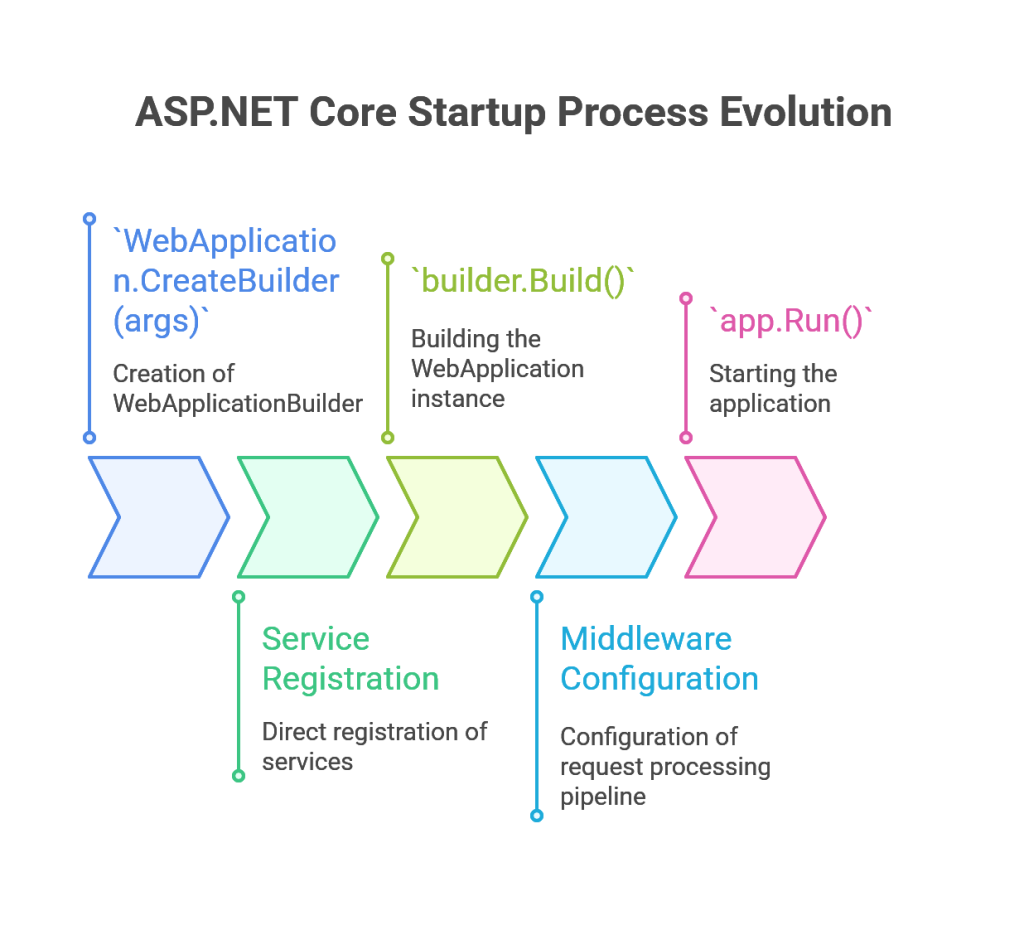
This evolution to a minimal hosting model is more than a mere syntactic simplification. It represents a strategic decision to lower the barrier to entry for new developers and to better align ASP.NET Core with the conventions of other popular, lightweight web frameworks like Node.js/Express. By unifying the startup logic into a single, top-to-bottom script in Program.cs, the framework becomes more approachable, especially for building small services and APIs where the ceremony of the older Program.cs/Startup.cs model could feel excessive.15 This directly addresses the “extensive learning curve” concern that could be associated with the older, more structured approach, making ASP.NET Core more competitive and appealing for the rapid development of microservices.1
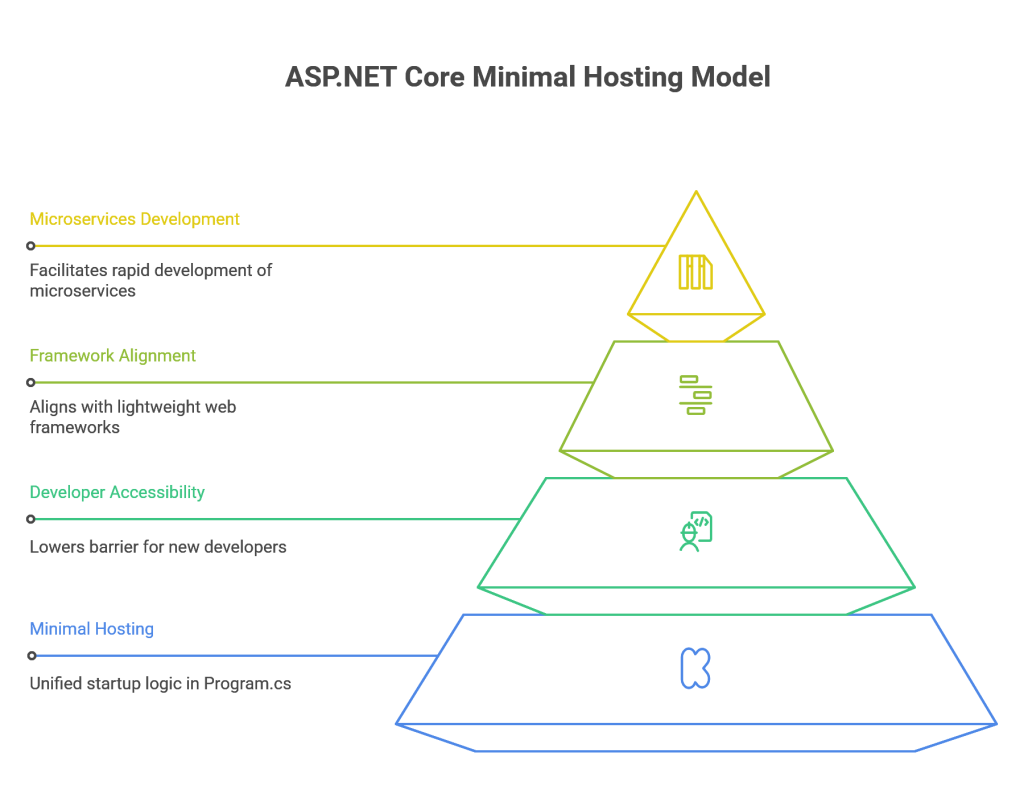
Integration of Configuration and Logging
The Generic Host automatically sets up a flexible configuration system that layers settings from multiple sources, including appsettings.json, environment-specific files (e.g., appsettings.Development.json), environment variables, and command-line arguments. It also integrates a robust logging infrastructure. Both the configuration (IConfiguration) and logging (ILogger<T>) services are registered in the DI container by default, making them readily available for injection throughout the application.12
Section 1.3: The Kestrel Web Server: Architecture and Operation
At the core of ASP.NET Core’s hosting model is Kestrel, the default in-process web server that is responsible for handling HTTP requests. Its design is a cornerstone of the framework’s high-performance promise.
Kestrel’s Role
Kestrel is a cross-platform, high-performance web server designed specifically for ASP.NET Core.18 It is included by default in project templates and is optimized to handle a large number of concurrent connections efficiently.3 Unlike traditional web servers, Kestrel is lightweight and focused on the task of processing HTTP traffic for the application it hosts.18
Internal Architecture
Kestrel’s performance stems from its low-level design. It operates directly on top of the operating system’s network stack, implementing the HTTP protocol over raw sockets.18 Its architecture is built around asynchronous I/O from the ground up, historically leveraging the high-performance
libuv library and now using.NET’s managed sockets. This allows Kestrel to handle thousands of concurrent connections with a small number of threads, which dramatically improves resource utilization and application responsiveness.18
The flow of a request through Kestrel is straightforward:
- An incoming TCP connection is accepted from the operating system.
- Kestrel parses the raw byte stream into a structured HTTP request.
- It constructs an
HttpContextobject, which encapsulates all information about the request and the eventual response. - This
HttpContextis then passed into the ASP.NET Core middleware pipeline for processing by the application logic.18 - Once the middleware pipeline completes and populates the response portion of the
HttpContext, Kestrel formats this into a valid HTTP response and sends it back to the client over the socket connection.18
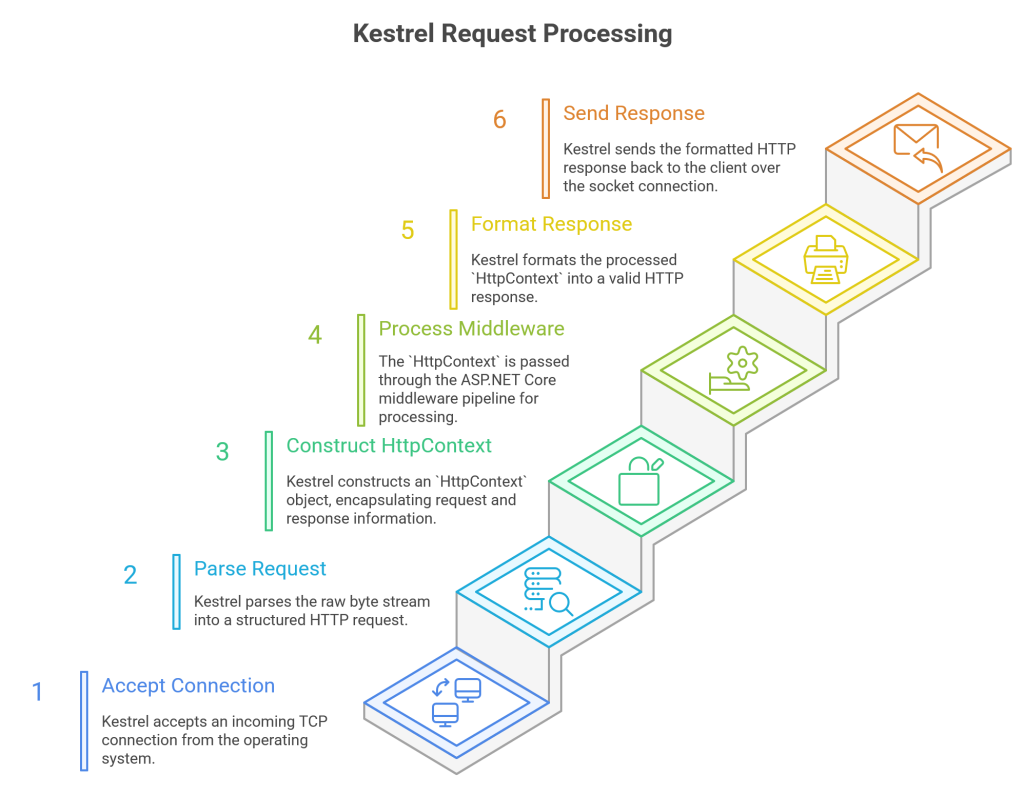
Hosting Models: Edge vs. Reverse Proxy
Kestrel offers two primary deployment configurations:
- Edge Server: Kestrel can be run as a standalone, internet-facing web server. This configuration is simple and offers maximum performance, as there are no intermediate hops.19
- Reverse Proxy: In most production scenarios, the recommended approach is to run Kestrel behind a more feature-rich reverse proxy server like IIS, Nginx, or Apache.18 In this model, the reverse proxy receives requests from the internet and forwards them to the Kestrel process. This configuration provides several advantages, including load balancing, SSL termination, response caching, and an additional layer of security, as it can filter and sanitize requests before they reach the application code.3
The design of Kestrel and its common use with a reverse proxy is a clear embodiment of the “do one thing and do it well” software design philosophy. Kestrel is not intended to be a monolithic, all-in-one web server with every conceivable feature. Instead, it is hyper-focused on being an exceptionally fast and efficient HTTP application server. The framework explicitly notes that Kestrel lacks some advanced features found in servers like IIS or HTTP.sys, such as kernel-mode Windows authentication or port sharing.19 This is not a deficiency but a deliberate design choice. By offloading infrastructure-level concerns like SSL management and load balancing to a dedicated reverse proxy, Kestrel remains lightweight, simple, and optimized for its core task: executing application code. This separation of concerns is a hallmark of modern, modular system design and is a key contributor to the overall performance and flexibility of ASP.NET Core.
Part II: The Request Processing Pipeline
Once Kestrel receives an HTTP request and wraps it in an HttpContext object, it hands control over to the ASP.NET Core request pipeline. This pipeline is a powerful and flexible mechanism composed of middleware components that collectively process the request and generate a response.
Section 2.1: Anatomy of Middleware
Conceptualizing the Pipeline
The request pipeline is best visualized as a sequence of software components, known as middleware, that are chained together.23 When a request arrives, it passes through each middleware in the chain. Each component has the opportunity to perform an action, such as logging, authentication, or routing. It can inspect and modify the
HttpContext before passing it to the next component, or it can decide to handle the request entirely and stop further processing.26
The RequestDelegate
The functional core of the pipeline is the RequestDelegate, a delegate that represents a function capable of processing an HttpContext. Each middleware component is essentially a RequestDelegate that wraps another RequestDelegate. A middleware component’s primary execution method receives the HttpContext and a reference to the next delegate in the pipeline, conventionally named next.23
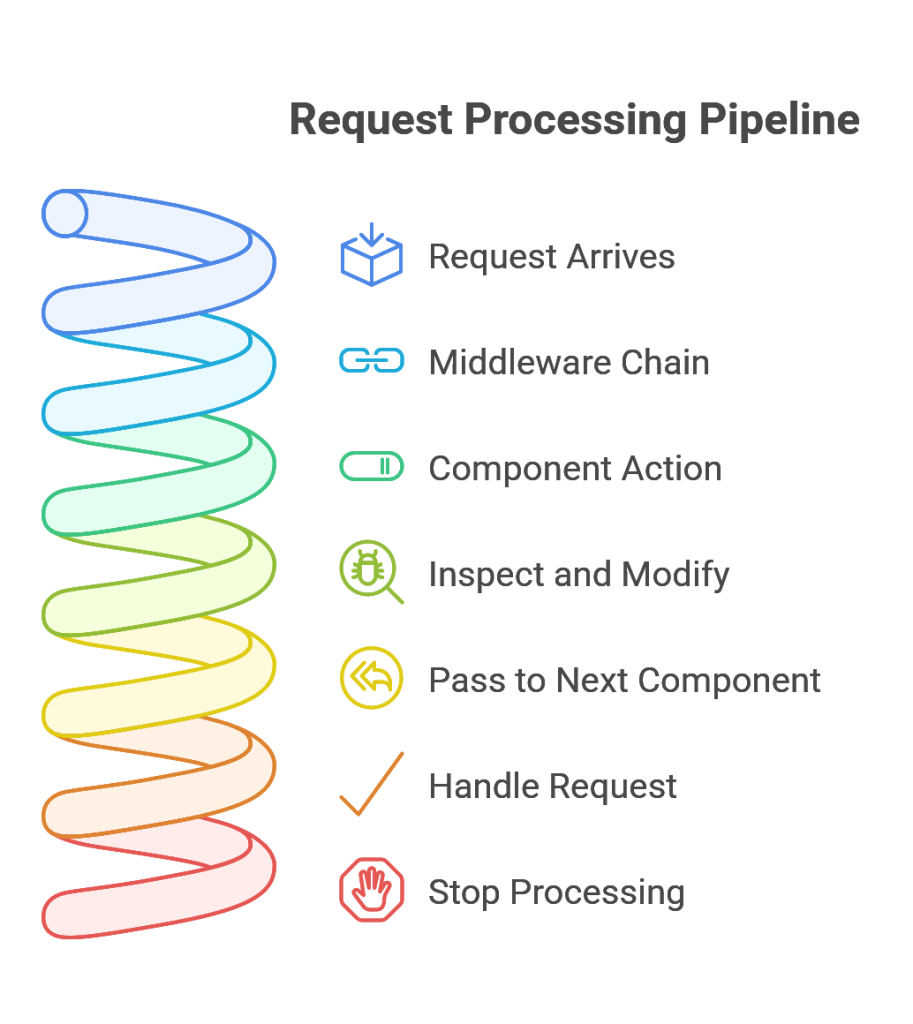
Within its logic, a middleware component faces a choice:
- Pass Control: It can perform its operations (e.g., adding a response header) and then invoke
await next(context);to pass control to the subsequent middleware in the chain. After thenextdelegate completes, control returns to the current middleware, allowing it to perform actions on the outgoing response. - Short-Circuit: It can decide to terminate the pipeline by generating a response itself and not calling
next. This is a common and efficient pattern used by middleware like the Static File Middleware (when a requested file is found) or Authentication Middleware (when a request is unauthorized and must be redirected).23
IApplicationBuilder and Pipeline Configuration
The middleware pipeline is constructed and configured in the Program.cs file using an instance of IApplicationBuilder, which is represented by the app variable in the minimal hosting model.27 Several key extension methods are used to add components to this builder:
app.Use(): This is the most common method for adding middleware. It accepts a delegate that takesHttpContextand thenextRequestDelegateas parameters. Middleware added withUse()is expected to potentially callnext.28app.Run(): This method adds a terminal middleware to the pipeline. The delegate it accepts only takes anHttpContextparameter; it does not receive anextdelegate because it is always the final component in its branch of the pipeline.25app.Map(): This method allows for branching the pipeline. It takes a request path and a configuration delegate. If an incoming request’s path matches the specified path, the request is diverted to a separate, isolated middleware pipeline defined within the configuration delegate.28
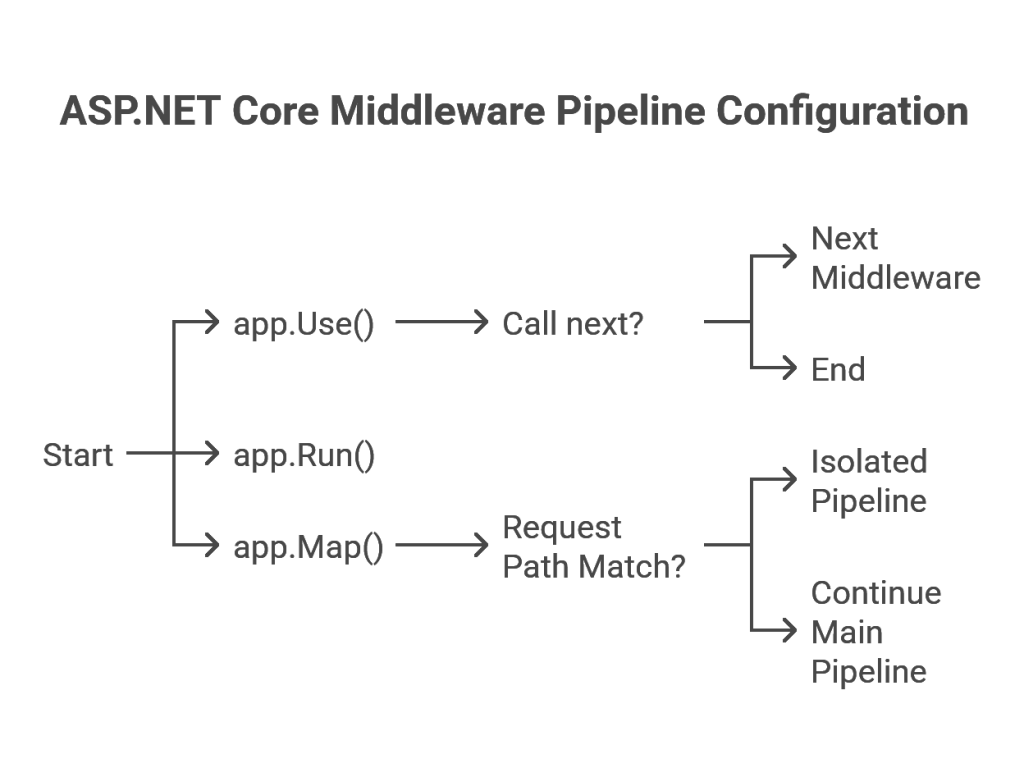
Section 2.2: The Criticality of Middleware Ordering
The sequence in which middleware components are registered with the IApplicationBuilder is not arbitrary; it is of critical importance for application functionality, security, and performance.23
Sequential Execution
Middleware components are executed in the exact order they are added in Program.cs for an incoming request. After the request reaches the end of the pipeline (or is short-circuited), the response flows back through the same components but in the reverse order.23 This allows middleware to perform actions both on the way in and on the way out.
A Standard Pipeline Walkthrough
A typical production-ready pipeline illustrates the importance of this ordering 23:
UseExceptionHandler/UseDeveloperExceptionPage: Exception handling middleware must be registered at the very beginning of the pipeline. This ensures it can catch any exceptions thrown by middleware components that are executed later in the chain.UseHstsandUseHttpsRedirection: Security-related middleware that enforces HTTPS and adds security headers should be placed early to ensure these policies are applied to all subsequent request processing.UseStaticFiles: This is often placed early in the pipeline. If a request is for a static asset like a CSS file or an image, this middleware can find the file, serve it, and short-circuit the pipeline, preventing the request from proceeding through unnecessary authentication and routing logic, which improves performance.UseRouting: This middleware is responsible for inspecting the request and determining which application endpoint (e.g., a controller action or a Minimal API handler) should ultimately handle it. It does not execute the endpoint but rather adds routing metadata to theHttpContext.UseAuthentication: This must come beforeUseAuthorization. This middleware inspects the request (e.g., for a cookie or a JWT bearer token) and attempts to identify the user, populating theHttpContext.Userproperty.UseAuthorization: Following authentication, this middleware checks if the identified user is permitted to access the specific endpoint that was selected by the routing middleware.UseEndpoints: This terminal middleware is responsible for executing the endpoint delegate that was selected byUseRouting.
Incorrect ordering can introduce severe vulnerabilities and bugs. For instance, if UseAuthorization were placed before UseAuthentication, the system would be trying to check permissions for an anonymous, unidentified user. Similarly, placing caching middleware before authentication could lead to the caching and subsequent public serving of protected data.23
Section 2.3: Implementing Custom Middleware
While ASP.NET Core provides a rich set of built-in middleware, applications often require custom components to handle unique cross-cutting concerns.
Convention-Based Middleware
The most common way to create a reusable middleware is to define a class that follows a specific convention 31:
- It must have a public constructor that accepts a
RequestDelegateparameter, which will be the reference to the next middleware in the pipeline. - It must have a public method named
InvokeAsync(orInvoke). This method must return aTaskand accept anHttpContextas its first parameter. The framework calls this method to execute the middleware’s logic. - Additional dependencies can be injected into the constructor (for services with a singleton lifetime) or into the
InvokeAsyncmethod’s signature (for services with scoped or transient lifetimes).31
Factory-Based Middleware (IMiddleware)
For more complex middleware that has
- Its own dependencies
- Needs to be resolved from the DI container with a specific lifetime (e.g., scoped)
Developers can implement the IMiddleware interface. This approach registers the middleware itself as a service in the DI container. The framework then resolves an instance of the middleware from the container for each request, allowing for dependencies to be injected into its constructor with the correct lifetime.32
Inline Middleware
For simple, one-off logic, middleware can be defined directly in Program.cs using a lambda expression with app.Use(). This is convenient for quick additions to the pipeline without the overhead of creating a separate class.31
The design of the middleware pipeline is a powerful and elegant implementation of the Chain of Responsibility design pattern. In this pattern, a request is passed along a chain of handler objects. Each handler decides either to process the request or to pass it to the next handler in the chain. This perfectly describes the behavior of ASP.NET Core middleware. Each middleware component is a handler, the HttpContext is the request object, and the next delegate is the link to the next handler. The ability to short-circuit the pipeline is equivalent to a handler processing the request and terminating the chain. Recognizing the pipeline as a formal design pattern provides a robust mental model for understanding its extensibility, the decoupling of its components, and the critical importance of handler order.
Part III: Dependency Injection: The Framework’s Central Nervous System
Dependency Injection (DI) is not an optional add-on in ASP.NET Core; it is a first-class citizen and a foundational principle upon which the entire framework is built.3 It serves as the central nervous system, managing the creation and lifecycle of objects and enabling the loosely coupled, testable, and maintainable architecture that defines the platform.
Section 3.1: The Problems Solved by Dependency Injection
To appreciate the role of DI, one must first understand the software engineering problems it is designed to solve. These problems are rooted in the concept of tight coupling between software components.
Deconstructing Tight Coupling
In code that does not use DI, a class is responsible for creating its own dependencies. For example, a ReportGenerator class might instantiate its DatabaseService dependency like this: var dbService = new SqlDatabaseService();. This line of code creates a tight coupling between ReportGenerator and the specific, concrete SqlDatabaseService class.35 This coupling makes the system rigid. If the application needs to switch from a SQL database to a different data source (e.g.,
MongoDatabaseService), the ReportGenerator class itself must be located and modified. In a large application, this dependency might be scattered across dozens of classes, making such a change brittle and error-prone.35
Enabling Testability
Tight coupling makes effective unit testing nearly impossible. The goal of a unit test is to test a single unit of code (a class or method) in isolation from its external dependencies. To test the ReportGenerator class, one would need to replace the real SqlDatabaseService—which might attempt to make an actual network connection to a database—with a “test double” like a mock or a stub that simulates the database’s behavior.5 With tight coupling, there is no mechanism to substitute the real dependency with a fake one without altering the production code of the
ReportGenerator class. DI solves this by externalizing the creation of the dependency, allowing a test harness to “inject” a mock implementation while the running application injects the real one.
Achieving Inversion of Control (IoC) and the Dependency Inversion Principle (DIP)
Dependency Injection is a specific technique for achieving a broader principle known as Inversion of Control (IoC). Instead of an object controlling the instantiation of its own dependencies, that control is “inverted” and delegated to an external entity, known as an IoC container or DI container.34 The container becomes responsible for “newing up” objects and providing them to the classes that need them.
This enables adherence to the Dependency Inversion Principle (DIP), one of the SOLID principles of object-oriented design. DIP states that high-level modules (e.g., business logic) should not depend on low-level modules (e.g., data access, infrastructure details); both should depend on abstractions (typically interfaces).34 DI facilitates this by allowing a class to declare a dependency on an interface (e.g.,
IDatabaseService) rather than a concrete type. The IoC container is then configured to provide the appropriate concrete implementation (SqlDatabaseService or MongoDatabaseService) at runtime.33
Section 3.2: The Built-in IoC Container
ASP.NET Core includes a simple, lightweight, yet powerful IoC container out of the box, removing the need for third-party DI libraries for most applications.33 The DI process involves two distinct stages: registration and resolution.
IServiceCollection and IServiceProvider
- Registration: During application startup in
Program.cs, services are registered with the container. This is done by addingServiceDescriptors to anIServiceCollection, which is exposed via thebuilder.Servicesproperty. A registration is essentially a mapping that tells the container, “When someone asks for this interface (the service type), provide them with an instance of this concrete class (the implementation type)”.38 - Resolution: After all services are registered, the framework builds an
IServiceProviderfrom theIServiceCollection. TheIServiceProvideris the actual container responsible for resolving services. Its core method isGetService(Type serviceType), which locates the registration for the requested service type and provides an instance of its implementation.35
The Dependency Graph
When a service is requested from the container (e.g., when a controller is activated), the resolution process is recursive. The container inspects the constructor of the requested type to identify its dependencies. It then resolves each of those dependencies, which may in turn have their own dependencies. This process continues until the container has constructed a complete dependency graph (also called an object graph or dependency tree) of all the objects required to fulfill the initial request.35 The built-in container manages the instantiation and injection of this entire graph automatically, freeing the developer from manual object construction.43
Service Lifetimes Explained
A critical responsibility of the IoC container is managing the lifetime of the objects it creates. Choosing the correct service lifetime is fundamental to application correctness, performance, and resource management.5 ASP.NET Core’s container supports three primary lifetimes:
Transient: A new instance of the service is created every single time it is requested from the container. This lifetime is best suited for lightweight, stateless services where no state needs to be shared between different parts of an operation.37Scoped: A single instance of the service is created per “scope.” In the context of an ASP.NET Core web application, a new scope is created for each incoming HTTP request. The same instance of a scoped service is then shared throughout the processing of that single request. This is the most common and generally recommended lifetime for services that need to maintain state within a request, such as an Entity FrameworkDbContextor a unit of work.37Singleton: A single instance of the service is created for the entire lifetime of the application. The instance is created the first time it is requested and is then shared across all subsequent requests and scopes. This is appropriate for services that are expensive to create, are thread-safe, and need to share a global state, such as a caching service or a configuration object.37
| Lifetime | Registration Method | Instantiation | Scope | Common Use Cases | Potential Pitfalls |
Transient | AddTransient() | Every time it is requested. | None. | Lightweight, stateless services; helper classes. | Can cause memory pressure if the service holds unmanaged resources and is resolved frequently. Not suitable for sharing state within a request. |
Scoped | AddScoped() | Once per client request (scope). | Per HTTP request. | Database contexts (DbContext), repository patterns, services that need to maintain state for the duration of a single request. | Must not be resolved by a singleton service directly, as this creates a “captive dependency.” |
Singleton | AddSingleton() | Once for the application’s lifetime. | Application-wide. | Caching services, logging configuration, application state management, services that are expensive to instantiate. | Can cause memory leaks if it holds references to scoped or transient objects. Must be thread-safe. Prone to the “captive dependency” problem. |
Table 2: Comparison of Service Lifetimes in ASP.NET Core. This table synthesizes definitions and use cases from sources 37 and highlights common pitfalls.35
Section 3.3: Dependency Injection in Practice
Understanding the theory of DI is one thing; applying it correctly within the framework is another. ASP.NET Core leverages DI in nearly every component, from controllers to middleware.
Standard Injection Patterns
- Constructor Injection: This is the most common, recommended, and explicit way to inject dependencies. Dependencies are declared as parameters in a class’s constructor. This pattern ensures that an object cannot be created without its required dependencies, placing it in a valid state from the moment of its instantiation.33
- Method Injection: In some cases, a dependency is only needed for a single method. Here, the dependency can be passed as a parameter to that specific method. This pattern is used extensively in Minimal APIs, where services are injected directly into the endpoint handler delegates.33 It can also be used in MVC controller actions by decorating a parameter with the “ attribute.36
Injecting Dependencies into Controllers
The following is a complete, practical example of using constructor injection in an MVC controller:
- Define the Interface and Service:C#
// Abstraction public interface IStudentRepository { Student GetStudent(int id); } // Concrete Implementation public class MockStudentRepository : IStudentRepository { public Student GetStudent(int id) { // In a real app, this would query a database. return new Student { StudentId = id, Name = "Jane Doe" }; } }This example defines anIStudentRepositoryinterface and a mock implementation.47 - Register the Service: In
Program.cs, the service is registered with the DI container, typically with a scoped lifetime.C#// Program.cs var builder = WebApplication.CreateBuilder(args); // Register the service with a scoped lifetime. builder.Services.AddScoped<IStudentRepository, MockStudentRepository>(); builder.Services.AddControllers(); var app = builder.Build(); //... configure pipeline app.MapControllers(); app.Run();This registration tells the container to provide aMockStudentRepositorywhenever anIStudentRepositoryis requested within a request scope.33 - Inject and Use in the Controller: The
HomeControllerrequests theIStudentRepositoryin its constructor. The DI container provides the instance automatically when the controller is activated to handle a request.C#[ApiController]
“)]
public class HomeController : ControllerBase
{
private readonly IStudentRepository _studentRepository;
// The dependency is injected here via the constructor.
public HomeController(IStudentRepository studentRepository)
{
_studentRepository = studentRepository;
}
[HttpGet("{id}")]
public Student GetStudentById(int id)
{
// The injected service is used here.
return _studentRepository.GetStudent(id);
}
}
```
This demonstrates the full lifecycle: registration in `Program.cs` and resolution via constructor injection in the controller.[33, 47]
The Special Case of Middleware
Injecting dependencies into middleware presents a unique challenge that reveals the intricacies of service lifetimes. Middleware components are constructed only once when the application starts, meaning they effectively have a singleton lifetime.45 If a middleware tries to inject a scoped service (like a
DbContext) into its constructor, a runtime exception will occur. This is because a long-lived singleton object cannot take a dependency on a short-lived scoped object—this scenario is known as a captive dependency.32
The correct way to use a scoped service within middleware is to inject it directly into the InvokeAsync method. The DI container is smart enough to resolve parameters for this method from the current request’s scope, not the application’s root (singleton) scope.
C#
public class MyCustomMiddleware
{
private readonly RequestDelegate _next;
// Only singleton dependencies can be injected here.
public MyCustomMiddleware(RequestDelegate next)
{
_next = next;
}
// Scoped and Transient services are injected here, per-request.
public async Task InvokeAsync(HttpContext context, IMyScopedService scopedService)
{
scopedService.DoWork();
await _next(context);
}
}
This pattern ensures that the middleware gets a fresh instance of the scoped service for each request, correctly respecting the service’s intended lifetime.31 This “problem” and its solution are not a flaw in the framework but a crucial teaching moment. It forces developers to confront and deeply understand the practical difference between the application’s root scope, where the singleton pipeline is constructed, and the per-request scope, where most application work happens. Mastering this concept is a key indicator of an advanced understanding of ASP.NET Core’s inner workings.
Conclusion and Recommendations
Synthesis of Architectural Principles
ASP.NET Core’s design is a cohesive and interconnected whole. Its success and power derive not from a single feature but from the synergistic interplay of its core architectural pillars. The modular design, breaking from the monolithic past, is the foundational choice that enables cross-platform deployment, high performance, and suitability for modern patterns like microservices and containerization. The flexible hosting model, with the high-performance Kestrel server at its core, allows for diverse and scalable deployment topologies, from simple edge servers to complex reverse-proxied environments. The middleware pipeline provides a powerful and extensible implementation of the Chain of Responsibility pattern, giving developers fine-grained control over the request and response lifecycle. Finally, first-class Dependency Injection acts as the central nervous system, the “glue” that binds these loosely coupled components together, ensuring the entire system is testable, maintainable, and adaptable to change.
Actionable Recommendations
Based on this in-depth analysis, the following recommendations are proposed for practitioners working with the framework:
- For Developers:
- Embrace the DI-First Paradigm: Treat Dependency Injection as a non-negotiable aspect of development. Always code against abstractions (interfaces) to decouple components and maximize testability.
- Master Service Lifetimes: Pay meticulous attention to the choice of service lifetimes. Default to
Scopedfor any service that interacts with request-specific resources like a database context. UseTransientfor lightweight, stateless helpers and reserveSingletonfor genuinely global, thread-safe services, being ever-watchful for the “captive dependency” anti-pattern. - Leverage the Pipeline: Use the middleware pipeline to handle cross-cutting concerns like logging, error handling, and security. This keeps controller and service logic clean and focused on business value.
- For Architects:
- Design for Modularity: Leverage the framework’s modularity and cross-platform capabilities to design scalable and resilient systems. The framework is purpose-built for microservice and container-based architectures; use it to its full potential.
- Choose Hosting Models Deliberately: The choice between running Kestrel as an edge server versus behind a reverse proxy should be a conscious architectural decision based on a clear analysis of security posture, infrastructure integration, and scalability requirements, not just on raw performance benchmarks. In almost all production scenarios, a reverse proxy is the more robust and secure choice.
- Promote Clean Architecture: Champion the Dependency Inversion Principle. Ensure that the application’s core business logic depends only on abstractions and remains isolated from infrastructure concerns like databases, file systems, or third-party APIs. The framework’s DI container is the primary tool for enabling and enforcing this critical separation.